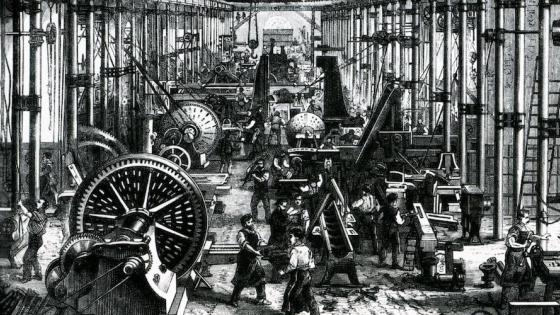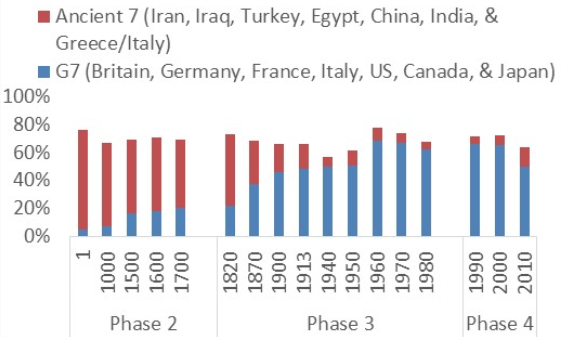
A long view of globalisation in short: Part 1 of 5
In this first of five posts looking at the long history of globalisation, Richard Baldwin explains how there have been four phases of globalisation in human history.
Search the site

In this first of five posts looking at the long history of globalisation, Richard Baldwin explains how there have been four phases of globalisation in human history.
This blog, and the four that will follow it, draw on Part 1 of my 2016 book, The Great Convergence.
In 1957, my father published a book called Economic Development: Theory, History, Policy. His opening lines:
“Since we are all too much affected by the times in which we live and are prone to generalise from transitory circumstances, we are not likely to gain a clear understanding … if we simply start with existing conditions and attempt to disentangle the major factors currently at work.”
I’d like to borrow his thought and modify it to "a clear understanding of globalisation”.
Today’s discussions on globalisation are “all too much affected by the times in which we live". Globalisation’s impact on the world economy was fairly steady for 175 years, and this led many to think that it would never change. But, as millions of people now realise, that’s wrong.
Globalisation isn’t like gravity or the speed of light – something that has always existed, exists now, and always will exist. Globalisation has changed radically in the past, and I think it’ll change radically in the future. In short, there's nothing radical about radical changes in globalisation. To understand why this is so, it’s necessary to go way back. Not just back to WW2. Not just back to the Industrial Revolution. Not just back to the Age of Discovery.
Let's go back to the beginning – the emergence of Homo sapiens in Africa, 200,000 or 300,000 years ago. When we do this, we discover that the magnitude of globalisation’s recent changes aren’t out of line with their historical (or prehistorical) equivalents.
To keep things intellectually bite-sized, I’ve spread the history out over five blog posts. Even so, a narrative covering hundreds of thousands of years will have to skip some of the less important details. To justify the omissions, we need to be clear about what 'important' means in this story. To do that, I’ll employ the classic definition of trade as an organising principle. Let me explain.
Trade is what happens when production and consumption are separated geographically. That means:
So what is important is how and when the production-consumption spatial relationship changes.
The first humans were hunter-gatherers. For them, production and consumption took place in the same space. They moved their consumption to the production (production for them meant a naturally occurring food source) because, for people living with stone age technology, it made more sense. Moving consumption to production was easier than moving production to consumption. As technology evolved, this spatial bundling of production and consumption relaxed.
And hence, the second important point:
In modern phases of globalisation, man-made barriers start to play a big role, but for most of globalisation’s history, technology or climate were the binding constraint. Specifically, production and consumption were bundled due to the high cost of moving goods, ideas, and people. The cost of moving these all three of these eventually fell, but not quickly, and not all at once. The order in which they fell – as we shall see – shaped history.
In the view I develop at length in my 2016 book, The Great Convergence, there have been four phases of globalisation in human history; here is a brief summary (the follow-on blog posts flesh these out). Climate change launched Phase 1.
Climate change allowed (or forced, it doesn't matter in this context) people out of Africa, and these people followed their food, fanning out across the globe. Consumption and production were bundled, but not in fixed locales.
The (Neolithic) agricultural revolution transformed Phase 1 into Phase 2.
For the first time, agriculture brought the food to the people who wanted to eat it. If you will, production was coming to consumption instead of the other way around. This phase saw the rise of seven ancient civilisations in what are known today as Iraq, Iran, Turkey, Egypt, China, India/Pakistan, and Greece/Italy. For the first time production and consumption were bundled in particular locations, so it could be called the 'first bundling'.
The steam revolution shifted Phase 2 to Phase 3.
The steam revolution and Industrial Revolution meant goods could be sent efficiently over long distances by land and sea. Steam thus unleashed spectacular transportation capabilities that made it economical to consume things that were made in far-away places.
This was the 'first unbundling' of production and consumption. It was caused by a steep drop in the cost of moving goods. But, even as production dispersed globally, it concentrated locally at the level of factories and industrial districts. For example, most of Britain deindustrialised during the Industrial Revolution. Cottage industries disappeared, and all the industrialisation took place in a handful of tightly circumscribed regions.
This combination of big markets and hyper-concentration of production would create what Kenneth Pomeranz called The Great Divergence in his 2001 book. In other words, this is when (and why) today’s rich nations got rich, while the rest of the world did not.
The Information and Communication Technology (ICT) Revolution shifted Phase 3 to Phase 4.
In the fourth stage, the ICT Revolution radically lowered the cost of moving ideas as well as goods over long distances. Therefore, it lowered the cost of coordinating complex activities at distance, which changed – and continues to change – the nature of globalisation. In particular, for the first time, it became organisationally feasible to separate stages of manufacturing production over long distances. Bombardier could make the tails of business jets in Mexico knowing that they’d fit on to fuselages made in Quebec. Factories could be unbundled geographically; I called this the 'Second Unbundling' in my 2006 paper, "Globalisation: The Great Unbundling(s)", that introduced the broader perspective on globalisation that forms the intellectual backbone of my 2016 book.
Once this production unbundling was feasible, the vast divergence in wages that had appeared during the Phase 3 made the separation profitable. Rich-nation firms offshored labour-intensive stages to nearby low-wage nations. As I argued in my 2016 book, this is a critical part of a 'Great Convergence' that is occurring now. It is what some others have called the emergence of emerging economies, or the 'rise of the rest'. It has brought the share of global GDP attributed to the G7 today back down to where it was in 1900.
Figure 1 illustrates what I like to call the 'shocking share shift'. It shows how the first unbundling (from 1820), and the second unbundling (from 1990) have altered the planet’s economic geography.
Figure 1 Shares of global GDP

Source: World Databank (GDP in US dollars) and Maddison data pre-1960, with author’s calculations.
So, now we have looked at the big picture, in subsequent posts I’ll examine Phases 1 through 4
Baldwin, R (2006), "Globalisation: The Great Unbundling(s)", Economic Council of Finland 20(3): 5-47.
Baldwin, R (2016), The Great Convergence: Information technology and the New Globalisation, Harvard University Press.
Meier, G M and Robert E Baldwin (1957), Economic Development: Theory, History, Policy, John Wiley and Sons.
Pomeranz, K (2000), The Great Divergence: China, Europe, and the Making of the Modern World Economy, Princeton University Press.
5,146 Reads